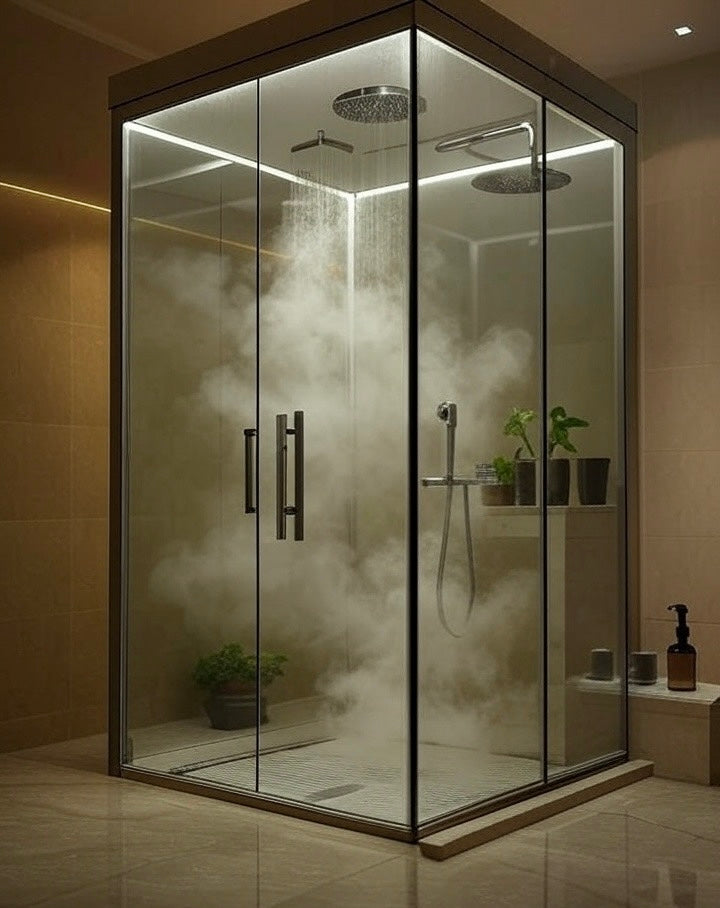Ever stepped out of a steamy shower only to be greeted by the shriek of a smoke alarm? You’re not alone. Steam Room vibes are lovely—false fire alerts, not so much. Yes, steam from your Steam Bath or shower can trigger smoke alarms. Keep reading to fix it fast.

Understanding Why Steam Triggers Smoke Alarms
How Smoke Alarms Work (Ionisation vs. Photoelectric)
Smoke detectors come in two main types: ionisation and photoelectric.
Ionisation alarms respond quickly to flames. They work by detecting disruptions in an electric current caused by particles in the air.
Photoelectric alarms, on the other hand, use a light beam that reacts to scattered particles—making them more sensitive to steam. This often leads to false alarms in steamy environments like bathrooms.
Ionisation Smoke Detectors and Steam Sensitivity
Ionisation detectors are generally less reactive to steam. Their primary job is to catch fast-burning fires, not moisture.
However, if the room gets humid enough, even they might get confused by heavy condensation.
Photoelectric Smoke Detectors and Steam
Photoelectric detectors are highly sensitive to small airborne particles, including the kind found in water vapour.
The steam bends the internal light beam, fooling the alarm into thinking there’s smoke. That’s why these models are the usual suspects when a post-shower alarm goes off.
The Science Behind False Alarms
Particle Size Similarity (Steam vs. Smoke)
Steam and smoke may seem different, but both are made of tiny particles. These particles are small enough to confuse optical sensors.
The detectors can't visually separate water vapour from smoke, so they react as though there's a fire. This is especially common in newer, more sensitive alarms.
Impact of High Humidity and Condensation
When steam fills a room, it raises the humidity level quickly.
If the room is poorly ventilated, moisture can settle on the smoke alarm itself. This makes the sensor even more likely to misfire, especially if it hasn’t been cleaned in a while.
Common Scenarios and Contributing Factors
Everyday Situations Where Steam Causes False Alarms
Showering with Poor Ventilation
Closed windows and weak extractor fans trap steam inside. Over time, it builds up and spills out into the hallway or ceiling.
Once there, it can drift straight into a nearby smoke detector.
Cooking Activities (Boiling, Steaming)
Steam isn’t just a bathroom problem. Cooking large meals or boiling water in a small space can easily set off alarms, especially without a proper hood or fan.
Using Humidifiers
Humidifiers add fine mist into the air, much like steam. If they’re placed too close to a smoke detector, they can cause unwanted alerts.
Drying Clothes Indoors
Drying clothes in a small room can elevate humidity significantly. When combined with other moisture sources, this may tip the alarm into thinking there's smoke.
Other Factors Increasing False Alarm Likelihood
Detector Placement (Too Close to Steam Sources)
Putting a smoke detector just outside a bathroom is a recipe for nuisance triggers. The moment you open the door, steam rushes out and rises toward the sensor.
Age and Condition of Smoke Alarm
Old alarms often become too sensitive or faulty. Their internal components degrade over time, making them more prone to false readings from steam or dust.
Dust and Debris Accumulation
Dust and grime can scatter light inside a photoelectric alarm, just like steam. Combined with high humidity, this can easily lead to false alarms.
Preventing Steam-Related False Alarms

Improving Ventilation
Using Exhaust Fans Effectively
Turn on your extractor fan before you start showering and leave it on afterwards. This helps push the steam outside rather than letting it pool near the ceiling.
Opening Windows and Doors
A slightly opened window or door during and after a shower can drastically reduce steam build-up. If that’s not an option, a dehumidifier can help.
Strategic Smoke Alarm Placement
Recommended Distance from Steam Sources
Keep smoke alarms at least 3 metres away from high-moisture sources. If your flat is small, consider placing alarms in areas that don't experience regular steam exposure.
Avoiding Direct Placement in Bathrooms or Kitchens
Never place a regular smoke alarm inside a bathroom. For kitchens, look into models designed to ignore light steam or minor cooking vapours.
Choosing the Right Smoke Alarm Technology
Benefits of Photoelectric Alarms for Steam-Prone Areas
Photoelectric alarms can still be used near bathrooms—but only if they're properly placed. Some modern models come with steam-resistant technology to reduce false alarms.
When to Consider Heat Detectors
Heat detectors trigger only when there’s a rapid temperature rise, not from moisture. They’re ideal for bathrooms and kitchens where steam is a frequent visitor.
Maintenance and Best Practices
Regular Cleaning of Smoke Alarms
Clean your smoke alarm every few months. A quick vacuum around the vents and a dry wipe down helps keep sensors accurate.
Replacing Old Alarms and Batteries
Most alarms need replacing every 8 to 10 years. Weak batteries or ageing sensors often lead to false alarms, so regular checks are essential.
Utilising Silence Features
Many newer alarms come with hush buttons or app-based controls. These features allow you to silence the alarm temporarily, without compromising your safety.
Conclusion
So—can steam from a shower set off a smoke alarm? Absolutely. But it doesn’t mean your home is doomed to noisy mornings.
With better airflow, smarter placement, and the right type of alarm, you can enjoy a hot shower without the fire drill.
Stay steamy—but keep it safe.
Takeaways
-
Yes, steam from showers can set off smoke alarms, especially optical (photoelectric) ones.
-
Steam and smoke contain similar-sized particles, which confuses many detectors.
-
Photoelectric alarms are the most sensitive to water vapour and prone to false alerts.
-
Poor ventilation and proximity to bathrooms or kitchens increase the chance of false alarms.
-
Prevention tips include: using extractor fans, relocating the alarm, choosing steam-resistant models, and cleaning alarms regularly.






